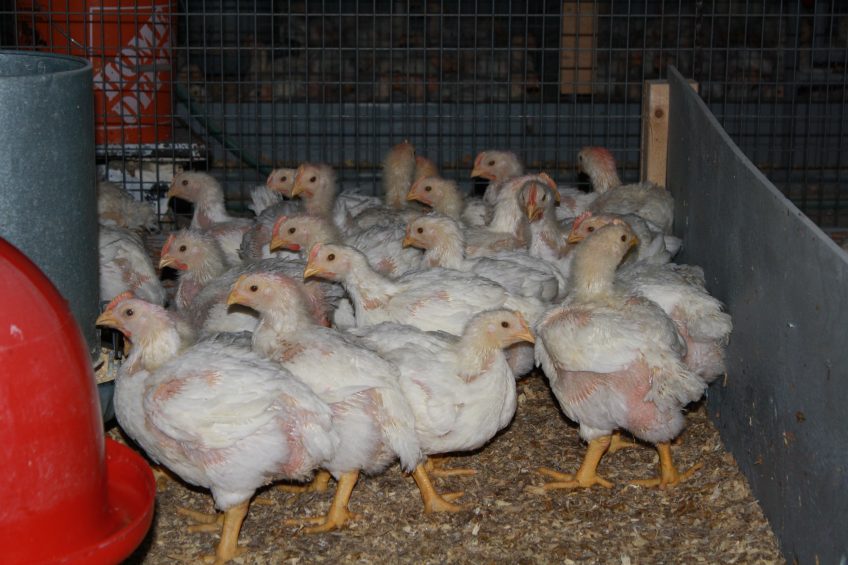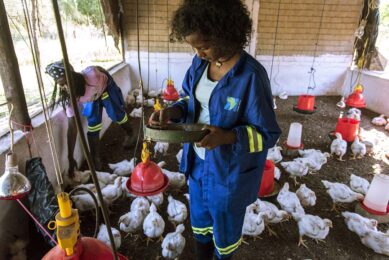Exciting alternatives to antibiotic use

Research on an essential plant oil component and disabling of a bacterial cell signaling system is about to proceed to the next level. Canadian researchers are making progress in the search for alternatives to antibiotics.
Alternatives to antibiotics are needed, for example, to prevent the growth of certain strains of Clostridium perfringens bacterium in the intestine, which produce toxins and cause necrotic enteritis (NE). One antibiotic alternative project inhibits C. perfringens growth directly using a naturally-occurring compound called citral, and the other involves inactivation of the bacterium’s own cell signaling system using genetic manipulation.
Both projects are headed by Dr Joshua Gong, a scientist at the Agriculture and Agri-Food Canada (AAFC) the Guelph Research and Development Centre. On-site colleagues include Dr Qi Wang, who co-leads the citral project and contributes expertise in encapsulation, Dr Moussa Diarra, who led the Clostridium challenge assays to evaluate citral in chickens, and Dr Dion Lepp, who contributed significantly to the research through exploring the role of cell signalling in the pathogenicity of C. perfringen. Dr John Prescott at the University of Guelph also collaborated on the cell signaling research.
Citral
Citral is a yellow liquid with a heavy lemon smell and strong anti-microbial properties that is found in the essential oils of plants such as lemongrass, verbena, citronella, lemon myrtle and lemon tea-tree. The team led by Gong and Wang had previously identified it as a potential alternative to antibiotics and notes that it can be encapsulated in powder form to protect it from loss during feed processing, storage and intestinal delivery. “In the present study,” Gong says, “we evaluated encapsulated citral both on a lab intestinal model and in chickens.”
The trial results were very good. Encapsulation did not adversely affect the antimicrobial activity of citral and indeed, the team found encapsulated citral to be superior to an un-encapsulated form in retaining antimicrobial activity after treatment with both simulated gastrointestinal fluids and in the presence of chicken intestinal digesta. In addition, the higher antimicrobial activity of encapsulated citral was confirmed in digesta samples from broilers that had been tube-fed encapsulated or un-encapsulated citral. “This was an expected result,” notes Wang, “as we designed the encapsulation for effective protection and delivery to the chicken gut.”
The scientists also fed citral to broilers infected with C. perfringens, and found that those fed diets supplemented with encapsulated citral at both 250 and 650 μg/g had significantly reduced intestinal NE incidence and lesions. These results are, in fact, comparable to the effects observed from feeding chickens diets containing antibiotics bacitracin and salinomycin. “These results indicate that citral can be used to control NE in chickens after proper protection by encapsulation,” says Gong. “It has proved that the concept of protected citral can be used as an alternative to antibiotics in feed for NE control, but more studies are required to follow up.”
Some of that work has already started. “Through experimentation, we have been able to develop an essential oil cocktail with lower concentrations of essential oils that demonstrate a similar effect compared to bacitracin in controlling NE in broilers,” says Diarra, “but we have not published the data yet.”

Genetic control of bacterial metabolic systems
In the other project, the team has been exploring a very different strategy to control NE. In a strain of C. perfringens that causes the disease, they have managed to inactivate a bacterial communication system known as ‘quorum sensing (QS)’. The system is used by many pathogenic bacteria to sense the population density in their vicinity.
Gong’s team has found that in the NE strain with the QS system inactivated (through mutating the relevant gene), each bacterium can no longer communicate well and therefore does not produce much NetB toxin, resulting in no appreciable presence of disease. These effects are reversed when the original gene is reintroduced into the mutant. Gong points out that whilst the bacteria may use the system to sense that there aren’t many of themselves and then overgrow in the intestine, “the system also regulates the pathogenicity of C. perfringens – how much virulence factor is produced (in this case, the NetB toxin required for NE development). This is a common mechanism in bacterial pathogens.”
In terms of how difficult it was to inactivate the QS system and what steps and discoveries were involved beforehand, Lepp says the work took several years. “QS has been shown to play a role in other diseases caused by C. perfringens, which led us to investigate it,” he says. “This is the first time, however, that it has been shown to play a role in NE.”
The next step is to develop compounds that can interfere with the QS system (inactivate it or cripple it to some extent), compounds that work similarly to any drug that acts on bacterial signaling pathways to prevent disease. “It’s an important direction for the future and we have not started that work yet,” Gong notes.
When asked about the big picture of replacing in-feed antibiotics, Gong observes that it’s a tough job, requiring efforts from not only those in the research community but in industry as well. “Science continues to increase our knowledge on bacterial agents,” he says. “As such, AAFC researchers are assessing alternatives to antibiotics using a scientific approach, as demonstrated by these 2 projects.” Gong notes that from the viewpoint of cost, no alternatives on the market can thus far compete with in-feed antibiotics, but if legislative changes move forward relating to the use of antibiotics in chicken production, other issues besides cost will be present.
Join 31,000+ subscribers
Subscribe to our newsletter to stay updated about all the need-to-know content in the poultry sector, three times a week. Beheer
Beheer








 WP Admin
WP Admin  Bewerk bericht
Bewerk bericht